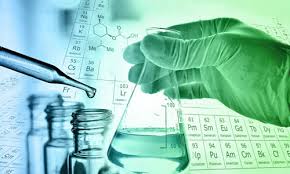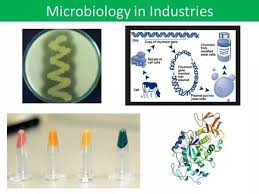Industrial Microbiology- Scope, industrial microbes and their products, industrially important microorganisms
Industrial Microbiology


Scope of Industrial Microbiology.
Microorganisms of industrial importance. Fermentation processes including culture methods – solid and submerged. Strain selection and development, media formulation and economics. Optimization of the fermentation process including fermentation design, fermenters and operations. Primary and secondary metabolites. Microbiological quality control of foods, drugs and cosmetics. Use of enzymes in the industries
Industrial Microorganisms and Their Products
The major organisms used in industrial microbiology are fungi (yeasts and molds) and certain prokaryotes, in particular species of the genus Streptomyces. Industrial microorganisms can be thought of as metabolic specialists, capable of synthesizing one or more products in high yield. Industrial microbiologists often use classical genetic methods to select high-yielding microbial variants, with the goal being to increase the yield of the product to the point that an economically feasible process is possible. Thus the behaviour of the actual production strain may be far removed from that of the original wild-type strain.
The use of microbes to obtain a product or service of economic value constitutes industrial microbiology. Any process mediated by or involving microorganisms in which a product of economic value is obtained is called fermentation. The terms industrial microbiology and fermentation are virtually synonymous in their scope, objectives and activities.
The microbial product may be
1.microbial cells (living or dead), microbial biomass, and components of microbial cells,
2. microbial metabolites,
3. intracellular or extracellular enzymes or
4. chemicals produced by the microbes utilizing the medium constituents or the provided substrate and/or modified compound that has been microbiologically transformed
5. Recombinant products through the DNA recombinant technology.
The services generated by microorganisms range from the
degradation of organic wastes,
detoxification of industrial wastes and toxic compounds,
the degradation of petroleum to manage oil spills, etc.
Industrial microbiology also encompasses activities like production of biocontrol agents, inoculants used as biofertilizers, biofuel: etc.
The activities in industrial microbiology begin with the isolation of microorganisms from nature, their screening for product formation, improvement of product yields, maintenance of cultures, mass culture using bioreactors, and usually end with the recovery of products and their purification.
Properties of a Useful Industrial Microorganism

A microorganism used in an industrial process must have other features besides just being able to produce the substance of interest in high yield.
1. First and foremost, the organism must be capable of growth and product formation in large-scale culture.
2. It should produce spores (if fungi or yeast) or some other reproductive cell form so that it can be easily inoculated into the large vessels used to grow the producing organism on an industrial scale.
3. It must also grow rapidly and produce the desired product in a relatively short period of time.
4. It must also be able to grow in a liquid culture medium obtainable in bulk quantities at a low price.
Many industrial microbiological processes use waste carbon from other industries as major or supplemental ingredients for large-scale culture media. These include corn steep liquor (a product of the corn wet-milling industry that is rich in nitrogen and growth factors) and whey (a waste liquid of the dairy industry containing lactose and minerals).

5. An industrial microorganism should not be pathogenic, especially to humans or economically important animals or plants. Because of the high cell densities in industrial microbial processes and the virtual impossibility of avoiding contamination of the environment outside the growth vessel, a pathogen would present potentially disastrous problems.
6. Finally, an industrial microorganism should be amenable to genetic manipulation because increased yields are often obtained by means of mutation and classical genetic selection techniques. A genetically stable and easily engineered microorganism is thus a clear advantage for an industrial process.
Scope of Industrial Microbiology.
Microorganisms of industrial importance. Fermentation processes including culture methods – solid and submerged. Strain selection and development, media formulation and economics. Optimization of the fermentation process including fermentation design, fermenters and operations. Primary and secondary metabolites. Microbiological quality control of foods, drugs and cosmetics. Use of enzymes in the industries
Industrial Microorganisms and Their Products
The major organisms used in industrial microbiology are fungi (yeasts and molds) and certain prokaryotes, in particular species of the genus Streptomyces. Industrial microorganisms can be thought of as metabolic specialists, capable of synthesizing one or more products in high yield. Industrial microbiologists often use classical genetic methods to select high-yielding microbial variants, with the goal being to increase the yield of the product to the point that an economically feasible process is possible. Thus the behaviour of the actual production strain may be far removed from that of the original wild-type strain.
The use of microbes to obtain a product or service of economic value constitutes industrial microbiology. Any process mediated by or involving microorganisms in which a product of economic value is obtained is called fermentation. The terms industrial microbiology and fermentation are virtually synonymous in their scope, objectives and activities.
The microbial product may be
1.microbial cells (living or dead), microbial biomass, and components of microbial cells,
2. microbial metabolites,
3. intracellular or extracellular enzymes or
4. chemicals produced by the microbes utilizing the medium constituents or the provided substrate and/or modified compound that has been microbiologically transformed
5. Recombinant products through the DNA recombinant technology.
The services generated by microorganisms range from the
degradation of organic wastes,
detoxification of industrial wastes and toxic compounds,
the degradation of petroleum to manage oil spills, etc.
Industrial microbiology also encompasses activities like production of biocontrol agents, inoculants used as biofertilizers, biofuel: etc.
The activities in industrial microbiology begin with the isolation of microorganisms from nature, their screening for product formation, improvement of product yields, maintenance of cultures, mass culture using bioreactors, and usually end with the recovery of products and their purification.
Properties of a Useful Industrial Microorganism
A microorganism used in an industrial process must have other features besides just being able to produce the substance of interest in high yield.
1. First and foremost, the organism must be capable of growth and product formation in large-scale culture.
2. It should produce spores (if fungi or yeast) or some other reproductive cell form so that it can be easily inoculated into the large vessels used to grow the producing organism on an industrial scale.
3. It must also grow rapidly and produce the desired product in a relatively short period of time.
4. It must also be able to grow in a liquid culture medium obtainable in bulk quantities at a low price.
Many industrial microbiological processes use waste carbon from other industries as major or supplemental ingredients for large-scale culture media. These include corn steep liquor (a product of the corn wet-milling industry that is rich in nitrogen and growth factors) and whey (a waste liquid of the dairy industry containing lactose and minerals).
5. An industrial microorganism should not be pathogenic, especially to humans or economically important animals or plants. Because of the high cell densities in industrial microbial processes and the virtual impossibility of avoiding contamination of the environment outside the growth vessel, a pathogen would present potentially disastrous problems.
6. Finally, an industrial microorganism should be amenable to genetic manipulation because increased yields are often obtained by means of mutation and classical genetic selection techniques. A genetically stable and easily engineered microorganism is thus a clear advantage for an industrial process.



Comments
Post a Comment